The NVIDIA GeForce GTX 660 Review: GK106 Fills Out The Kepler Family
by Ryan Smith on September 13, 2012 9:00 AM ESTOC: Power, Temperature, & Noise
Before wrapping things up, we wanted to quickly take a look at the overclocking potential of the GTX 660. As the first GK106 product GTX 660 should give us some idea as to how capable GK106 is at overclocking, though like GK104 we’re eventually at the mercy of NVIDIA’s locked voltages and limited power target control.
In its rawest form, GTX 660 will have two things going against it for overclocking. First and foremost, as the highest clocked GK106 part it’s already starting out at a fairly high clockspeed – 980MHz for reference cards, and upwards of 1050MHz for factory overclocked cards – so there may not be a great deal of overclocking headroom left to exploit. Furthermore because NVIDIA is keeping the power consumption of the card low (it needs to stay under 150W max), the maximum power target is the lowest we’ve seen for any GTX 600 card yet: it’s a mere 110%. As a result even if we can hit a large GPU clock offset, there may not be enough power headroom available to let the GPU regularly reach those speeds.
Memory overclocking on the other hand looks much better. With the same memory controllers and the same spec’d RAM as on the other high-end GTX 600 cards, there’s no reason to believe that the GTX 660 shouldn’t be able to hit equally high memory clocks, which means 6.5GHz+ is a reasonable goal.
| GeForce GTX 660 Overclocking | ||||||
| Ref GTX 660 | EVGA GTX 660 SC | Zotac GTX 660 | Gigabyte GTX 660 OC | |||
| Shipping Core Clock | 980MHz | 1046MHz | 993MHz | 1033MHz | ||
| Shipping Max Boost Clock | 1084MHz | 1123MHz | 1110MHz | 1123MHz | ||
| Shipping Memory Clock | 6GHz | 6GHz | 6GHz | 6GHz | ||
| Shipping Max Boost Voltage | 1.175v | 1.175v | 1.162v | 1.175v | ||
| Overclock Core Clock | 1080MHz | 1096MHz | 1093MHz | 1083MHz | ||
| Overclock Max Boost Clock | 1185MHz | 1174MHz | 1215MHz | 1174MHz | ||
| Overclock Memory Clock | 6.7GHz | 6.9GHz | 6.7GHz | 6.5GHz | ||
| Overclock Max Boost Voltage | 1.175v | 1.175v | 1.162v | 1.175v | ||
Throwing in our factory overclocked cards from our companion roundup, our core overclocking experience was remarkably consistent. The difference in the max boost clock between the slowest and fastest card was a mere 41MHz, with the Zotac card being a clear outlier compared to the rest of our cards. This comes as no great surprise since all of these launch cards are using the NVIDIA reference PCB, so there’s little room at this moment for overclocking innovation.
Memory overclocking is as volatile as ever, with a 400MHz spread between our best and worst cards. Again with the use of the reference PCB (and the same Samsung RAM), memory overclocking is entirely the luck of the draw.
For the moment at least GTX 660 overclocking looks to be on a level playing field due to all partners using the same PCB. For overclockers the choice of a card will come down to pricing, what cooler they prefer, and any preference in vendor.
The end result of all of this is that at best we’re seeing 100MHz overclocks (going by the max boost clock), which represents roughly a 10% overclock. Coupling this with a good memory overclock and the 10% increase in the power target will result in around a 10% increase in performance, which isn’t shabby but also is the same kind of shallow overclocking potential that we’ve seen on cards like the GTX 670 and GTX 660 Ti. All told the GTX 660 isn’t a poor overclocker – 10% more performance for free is nothing to sneeze at – but it’s also not going to enamor itself with hardware overclockers who like to chase 20% or more.
Moving on to our performance charts, we’re going to once again start with power, temperature, and noise, before moving on to gaming performance. Due to popular demand we’ll also be including overclocking results with just a 110% power target so that you can see the impact of adjusting the power target separately from the clock offsets.
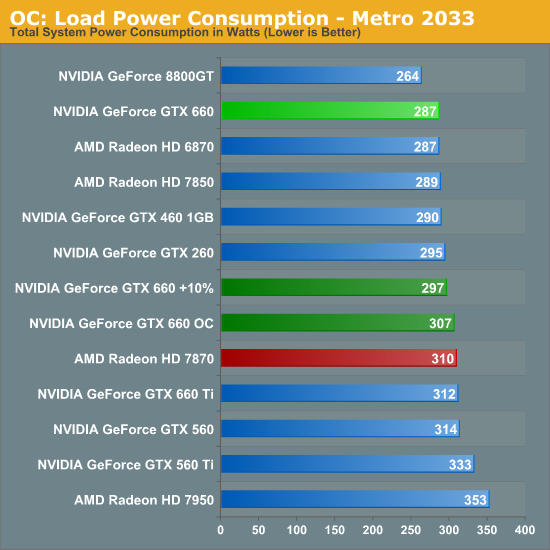
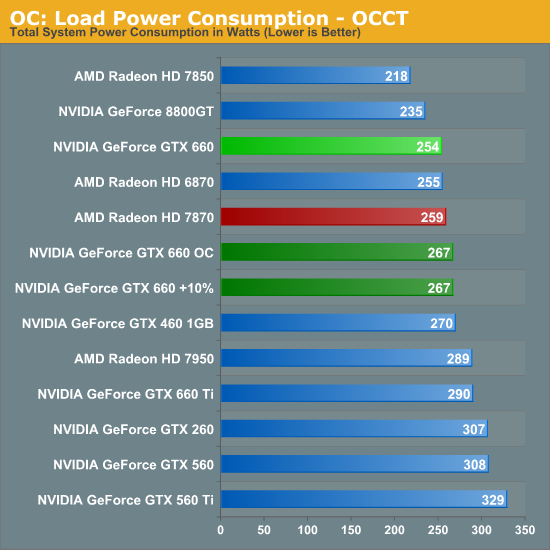
With a 110% power target we should be seeing an 11W-14W increase in power consumption, which is indeed roughly what we’re seeing at the wall after accounting for PSU inefficiencies. In Metro this is just enough of a difference to erase most of the GTX 660’s power consumption advantage over the GTX 660 Ti, though the GTX 660 still draws marginally less power than the stock 7870. Meanwhile under OCCT the GTX 660 now draws more power than the 7870, but still is still drawing over 20W less than the stock GTX 660 Ti.
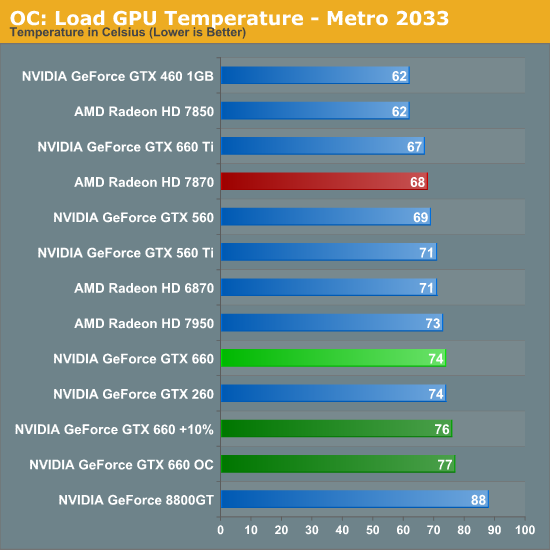
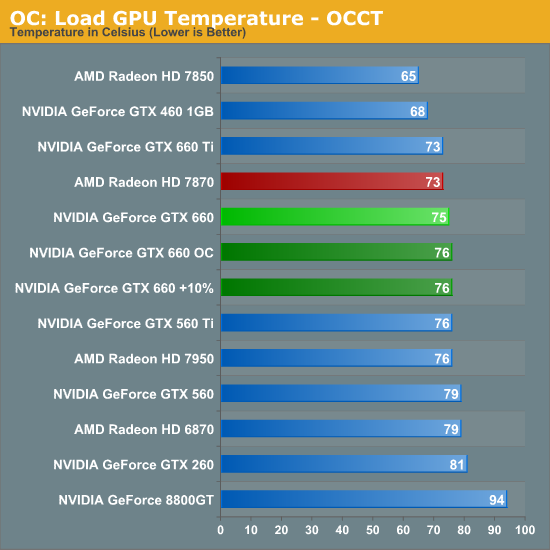
Our increased power consumption pushes temperatures up by another 2-3C. This is nothing a blower can’t handle, let alone an open-air cooler.
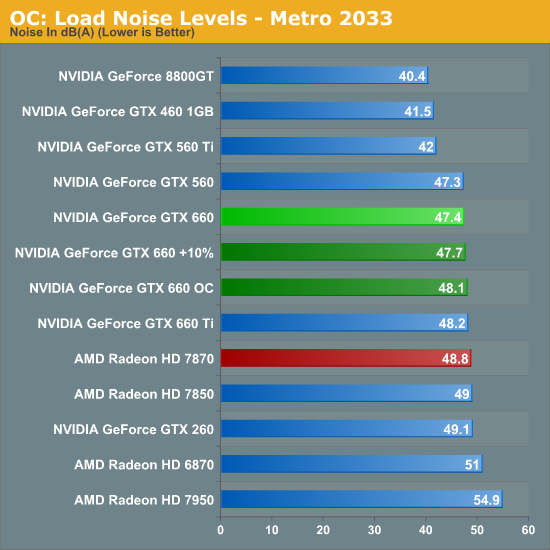
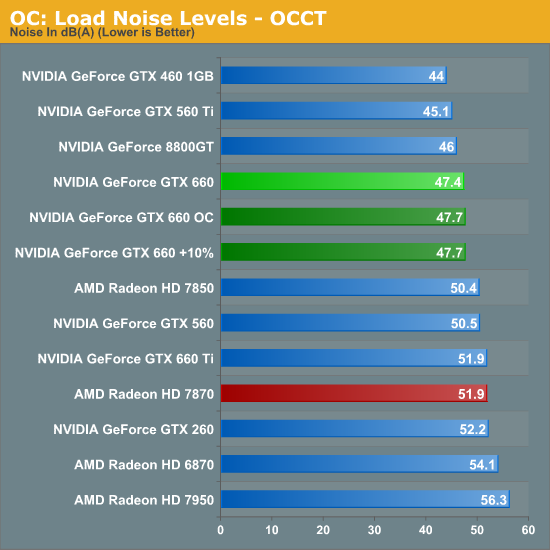
Interestingly enough, despite the increase in power consumption and temperatures, overclocking has almost no impact on noise. In the worst case scenario our GTX 660’s increased its fan speed by all of 2%, which increases noise by less than 1dB. As a result the amount of noise generated by the overclocked GTX 660 is practically identical to that generated by the stock GTX 660, and still below the reference 7870.










147 Comments
View All Comments
Galidou - Thursday, September 20, 2012 - link
Whenever I see CeriseCogburn commenting, Chizow is not, and vice versa....If you never heard about price fixing, sorry for you but it's a fact, THAT is a fact, people don't have to beleive in that, it's happening right now and always has been and beleive me it will continue, because almost every company in the world is greedy even if it means communicating with the competition to maximize profit....
CeriseCogburn - Thursday, November 29, 2012 - link
Gal, you silly gal, Chizow knows a lot more than I do, but I'll say this, you're an insane and incorrect amd fanboy of the worst kind.I hope david's butt remains a delicacy to you, even after the corpse is buried, which is, by the way, to happen, very soon.
CeriseCogburn - Thursday, November 29, 2012 - link
Galidou, you win NOTHING for being a lying sack, then whining when someone is so sick of your complete bs, they offend your idiot retarded estrogen doused amd licking being because they aren't a sick lying gasbag biased amd pig.Glad that religious Bible story has you kissing david amd's tokus furiously though, as that surely commands respect.
LOL
NOT !
Oh, were you insulted ?
Let's hope so, because of course, you tell so many lies, it's IMPOSSIBLE for you to not be insulted.
rarson - Tuesday, September 18, 2012 - link
AMD's pricing doesn't need to be defended because anyone with a grasp of basic economics can easily understand why they priced them the way they did. That's why most people are ignoring your inane and mind-bogglingly stupid comments."How do you feel now about those $550, $450, and $350 pricepoints you so vigorously defended when the 7970/7950/7870 launched?"
Absolutely fine, dumbass, because it's September now. Duh.
"So just as I asked then"
Nobody cares, dude. Go fanboy somewhere else.
chizow - Tuesday, September 18, 2012 - link
Yes anyone with a basic grasp of economics would never have defended the worst increase in price and performance in the last decade and then be OK with the biggest price drop in the least amount of time within the same generation. AMD now holds the notorious distinction for both and their fanboys (like you) get to suffer the consequences.How much did the GTX 580 cost 15 months after release? $500 still dumbass, duh, now go fanboy somewhere else? Parts like this don't lose their value unless they suck, or their pricing sucks, or both, but obviously you're too oblivious or stupid to realize this, or maybe you're just accustomed to it as an AMD fan.
CeriseCogburn - Thursday, November 29, 2012 - link
You're an idiot.AMD cost me plenty, and I will NEVER fall for your stupid amd lies, ever again.
Klimax - Saturday, September 15, 2012 - link
A thing: Dirt Showdown is AMD game using DC codepath optimised ONLY for Radeons severly penalising nVidia's cards. It is not valid for any comparsions.(At least not with that option enabled)
chizow - Thursday, September 13, 2012 - link
Just wondered if there was any news about price drops for higher-end SKUs. It becomes more obvious with every newly released SKU that the original asking prices from both AMD and Nvidia on 28nm parts were far too high. $350 for a 7870 looks like a complete debacle at this point given a $229 part outperforms it just a few months later.Also it looks like the Summer 2012 GPU pricing chart needs to be adjusted for the GTX 660 (it shows $239).
Thanks for the commentary on page 3 about Nvidia's Competition. Much like Intel, they still need to compete with themselves to entice owners of their previous products to upgrade. I'm glad someone else gets it, its pretty obvious Nvidia does as well. I guess they heard the complaints of all their enthusiasts when asking $500 flagship dollars for a part based on a midrange ASIC.
RussianSensation - Thursday, September 13, 2012 - link
A couple months?HD7850 - $249 March 3, 2012
HD7870 - $349 March 3, 2012
GTX660 - $229 September 13, 2012
It's been 7 months.
Someone who bought an HD7850 and OCed it enjoyed ~ GTX580 / HD7950 level of performance for 7 months now. Using the same exact logic you have just outlined, then we should recommend people to wait 7 more months for HD8000 series and skip GTX660 because for them the 660 would be an "early adopter" premium vs. HD8870. See how illogical your comment is?
GPUs often drop in price over time as the generation goes on.
Interesting how GTX280 for $649 and GTX260 $399 weren't a problem for you.
chizow - Thursday, September 13, 2012 - link
Except we've already covered this pricing debacle months ago, pretty sure you were onboard then, what happened since then?The 7870 was already vastly overpriced because it offered 6970/GTX 570 at.....6970 and GTX 570 prices. Parts that were already widely available for at least 20 months prior to the 7870's launch at the exact same prices. Anyone who already had that performance level would have no incentive to sidegrade to a 7870 at that pricepoint.
What is obvious now as it was then is that there was no movement in terms of price:performance that you would expect from a new generation, the metric didn't shift at all for 28nm until Kepler launched. Now that Kepler has finally trickled down to this performance level, its that much more clear. Bringing your 8870 argument into the fold, I wouldn't agree with that view either as I would expect the 8870 to offer more performance at a lower pricepoint, not the same performance at the same price as is the case with the 7870 at launch.
I don't know why you're trying to defend AMD's horrid 28nm pricing but the fact of the matter is, the current pricing structure is really what 28nm should have been from the outset, anyone who bought in March and didn't actually need a new GPU is undoubtedly feeling the burn of all the recent price drops, but hey, at least its not as bad as Facebook's IPO?
And no, GTX 260/280 weren't a problem for me because the difference is with those parts, the performance justified the premium relative to the last generation of cards (8800GT/GTX). This generation clearly does not adhere to those same expectations, which again, is a view I'm pretty sure you were onboard with months ago. What Nvidia didn't expect was for AMD to lowball them so much on a certain performance level, something AMD has clearly worked to remedy with each successive generation with their increases in asking prices for their 1st and 2nd tier single-GPU SKUs.